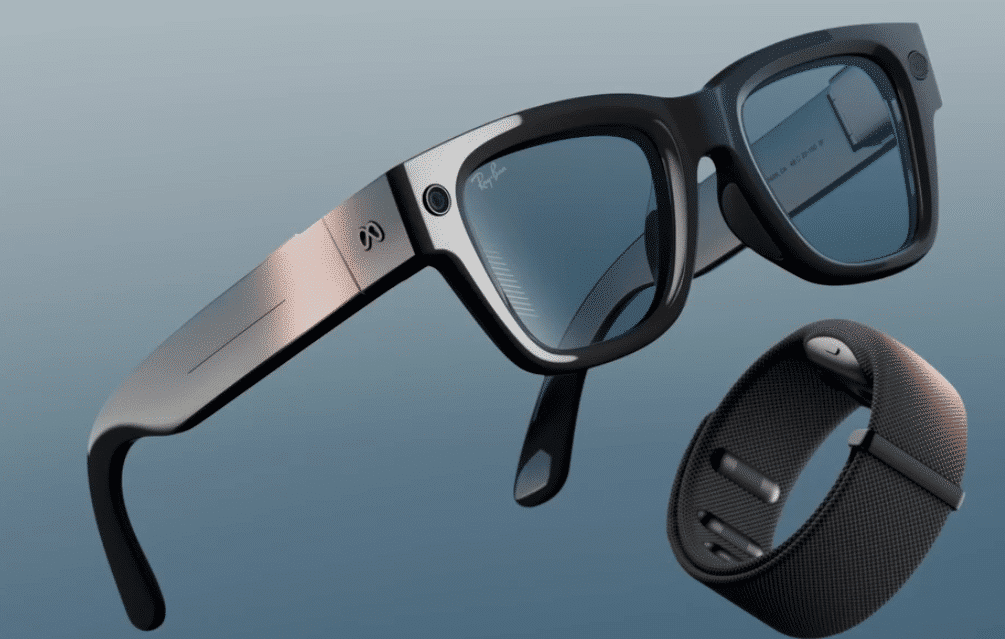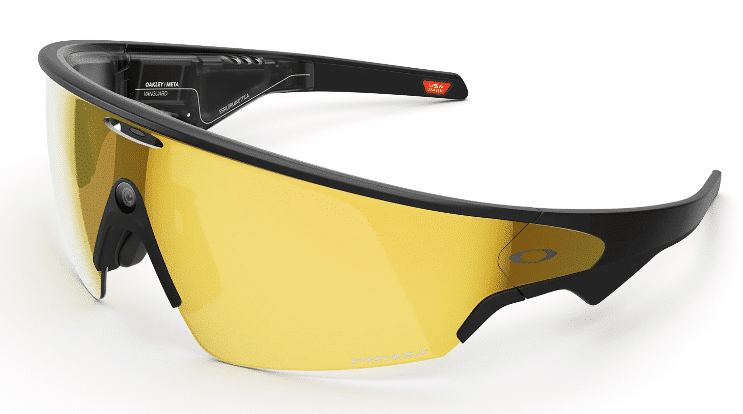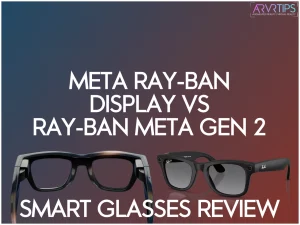Should you buy the new Ray-Ban Meta 2 glasses with improved audio and video capture, or spring for the Meta Ray-Ban Display with the full built-in display in the right lens and neural wristband? In this Meta Ray-Ban Display vs Ray-Ban Meta 2 comparison guide, I’ll compare both glasses in detail to help you decide which one is right for you!
Quick Summary
| Feature | Meta Ray-Ban Display (Gen 3) | Ray-Ban Meta 2 (Gen 2) |
|---|---|---|
| Display | Monocular color display in right lens (600×600 resolution, 20° FOV, 90Hz, up to 5,000 nits brightness) | No display (uses audio prompts and LED indicators) |
| Camera | 12 MP with 3× zoom and viewfinder | Standard camera |
| Audio | 6 microphones + enhanced open ear audio with conversation focus | Open ear audio + microphones (less advanced) |
| Controller | Neural Band wristband with EMG gesture control (18-hour battery, IPX7 water resistant) | Touch controls on frames |
| AI Features | In-lens AI responses, live captions, translations, navigation, notifications + voice commands | Voice-based AI, live translation, conversation focus, object identification |
| Price | $799 USD | Starts at $379 USD |
Choose Meta Ray-Ban Display if: You want to see information without looking at your phone and value the futuristic display + gesture control experience
Choose Ray-Ban Meta 2 if: You want lighter, more affordable glasses primarily for audio, calls, photos, and voice AI features
Meta Ray-Ban Display Overview
Meta unveiled the Meta Ray-Ban Display glasses at Meta Connect on September 17, 2025, marking the next step in its wearable AI lineup. These are the first Ray-Ban glasses to feature a built-in display in the right lens, projecting text, images, navigation prompts, and even video calls directly into the user’s field of vision.
The evolution of the Meta smar glasses began with the first generation, which offered more basic features, no in-lens screen, and lower pricing, followed by the next generation with significant technological improvements. The Meta Ray-Ban Display now represents the latest advancement in Meta’s smart glasses lineup, going with an augmented display in one eye.

The Ray-Ban Meta 3 glasses feature a new Neural Wristband, six hours of battery life, and a collapsible charging case to extend usage throughout the day.
Key Features
- Monocular color display built into the right lens, with about 600×600 resolution, “42 pixels per degree,” and a 20° field of view.
- Very high brightness (up to ~5,000 nits), so the display remains visible even in bright sunlight.
- 90 Hz refresh rate on the display.
- A 12 MP camera with 3× zoom and a viewfinder is displayed via the in-lens display.
- Six microphones and an open ear audio player for audio input/output.
- Battery life of about 6 hours of mixed use for the glasses, plus a charging case that extends that to 30 hours total.
- The Neural Band (wrist controller) uses EMG to detect muscle signals and small hand gesture motions (swipes, taps, writing in the air) for hands-free control.
- Neural Band has its own battery life (18 hours) and is water resistant (IPX7).
- Support for prescription lenses, Transitions lenses, and polarized lenses, with frame options in standard and large sizes and color options such as black and tan. Pricing varies depending on the lens type and configuration.
Ray-Ban Meta Gen 2

The Gen 2 Ray-Ban Meta glasses represent an upgrade over the first generation, offering enhanced features and improved performance. These are an upgraded version of the AI Glasses without an internal display.
The Gen 2 glasses are lighter, more affordable, and still pack a punch in terms of features you would like. The improved extended battery life allows users to capture more photos and create more memories during typical use. A key feature is the hands-free camera, which lets you capture photos and videos effortlessly using voice commands.
There are tons of frame options to choose from, as well as a ton of combinations of lenses. These start at $379 USD for standard lens options and increase for different lenses.
Ray-Ban Meta Models
Like the first generation, the second generation Ray-Ban Meta glasses offer the same models:
- Ray Ban Meta Wayfarer
- Ray Ban Meta Skyler
- Ray Ban Meta Headliner
Shop for yours in the link below to compare the look and feel of each model!
Oakley Meta Vanguard
The Oakley Meta Vanguard is an alternative to the Oakley Meta HSTN, Oakley Meta HSTN glasses, and Ray-Ban Meta Smart Glasses. The Vanguard offer a sports-oriented design with an ultrawide camera and fitness integrations such as Garmin and Strava.
The Oakley models focus on performance features like higher camera resolution and longer battery life, making them ideal for outdoor adventures. These glasses start at $499 USD.

Meta Ray-Ban Display vs Ray-Ban Meta 2: Display
The biggest difference in display between the Meta Ray-Ban Display and the Ray-Ban Meta Gen 2 comes down to the addition of a built-in screen. Meta 3 introduces a monocular color display in the right lens. This display is capable of showing notifications, navigation, video calls, and other glanceable information. It’s bright enough to remain visible in sunlight and integrates smoothly with the classic Ray-Ban style, though the extra hardware makes the glasses heavier than Gen 2.
The Ray-Ban Meta Gen 2 glasses do not include a display, instead relying on user audio prompts, LED indicators, or their phone for visual feedback. This makes the Gen 2 Ray-Ban Meta Glasses lighter, simpler, and more affordable, but it lacks the convenience and immersion of an in-lens display screen.

Meta Ray-Ban Display vs Ray-Ban Meta: Audio
The most significant difference in audio between the Meta Ray-Ban Display and the Ray-Ban Meta Gen 2 is the improvement in microphone and speaker quality. The Meta 3 Ray-Ban Glasses feature an upgraded six-microphone array combined with an enhanced open ear audio player, designed to deliver more straightforward voice pickup and more immersive sound.
This setup makes calls, video chats, and voice assistant interactions feel more natural, while still maintaining discreet audio for the person wearing the glasses.
The Ray-Ban Meta 2 glasses also include an open ear audio player and microphones, but the hardware is less advanced and can struggle with clarity in loud settings. The newly revealed conversation focus feature on Meta 3 helps reduce ambient background noise, amplifying voices for clearer conversations even in busy environments.
While Gen 2 still offers hands-free music playback and voice assistant use, the audio experience isn’t as rich or refined as that of Meta 3. This makes Gen 2 more straightforward and more budget-friendly, but Meta 3 clearly raises the bar.
Meta Ray-Ban Display vs Meta Ray-Ban 2: AI Features
The Ray-Ban Meta Display adds a big leap forward in AI capability by combining its in-lens display with a Neural Band wrist controller to enable more intuitive and flexible interaction. Users can see Meta AI responses, step-by-step instructions, live captions (including translations), and notification previews right in the lens.
AI voice commands work in conjunction with hand gestures detected by the wristband, allowing many tasks to be completed discreetly without the need to reach for a phone.
The Ray-Ban Meta Gen 2 glasses offer AI features without a built-in visual display. AI works through voice, audio feedback, live translation, and “Conversation Focus” (which amplifies the voices of people you’re talking to while suppressing background noise).
Users can also ask “Hey Meta” to identify objects or ask about what they see, use live translation across multiple languages, and tap gestures or the touchpad for AI interactions. While Gen 2 offers many functional smart AI capabilities, it cannot display content through a built-in display, resulting in a less immersive experience.
Are the Meta Ray-Ban Display’s Worth the Upgrade?
If you value having a heads-up, in-lens display for navigation, notifications, live captions, or viewing content without looking down at your phone, then Meta 3 delivers a clear leap over Gen 2. The addition of the Neural Band wrist controller also brings a more natural way to interact with the display, which promises improved convenience and a more futuristic feel.
These upgrades do come at a cost, both in price and heavier weight, shorter battery for display-rich usage, and potentially more fragile hardware.
If you primarily use the AI glasses for audio, casual calls, occasional photos or videos, or want lighter, more affordable smart glasses, sticking with Gen 2 Ray-Ban Meta Glasses might still make a lot of sense. But, if you wished you could “see” things (maps, text, alerts) without pulling out your phone, then the upgrades in the Display model are worth the investment.


